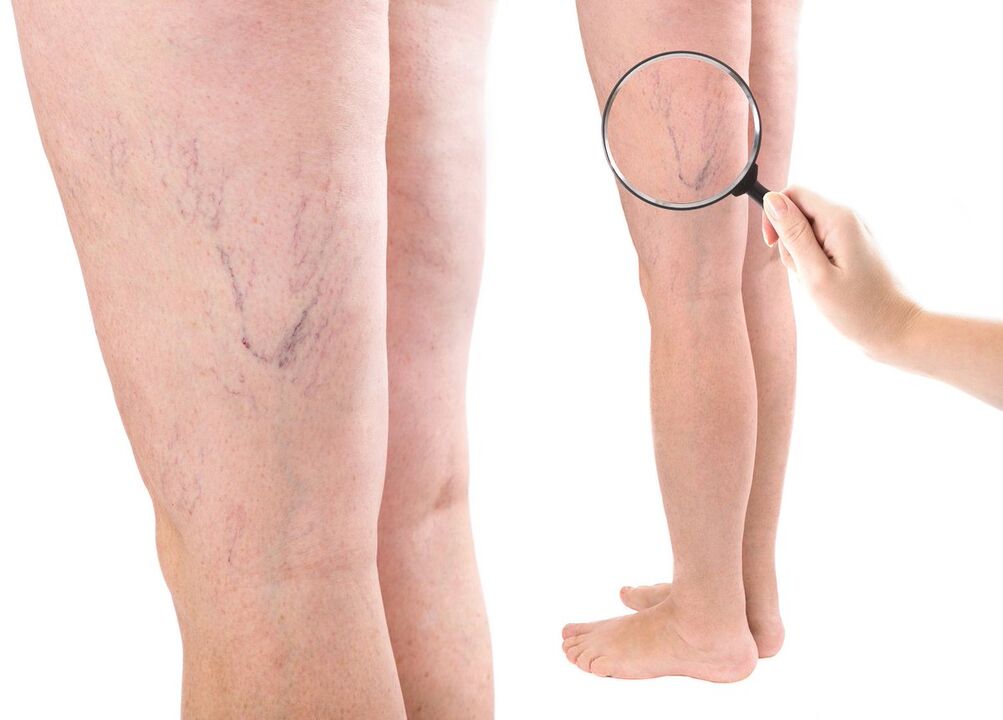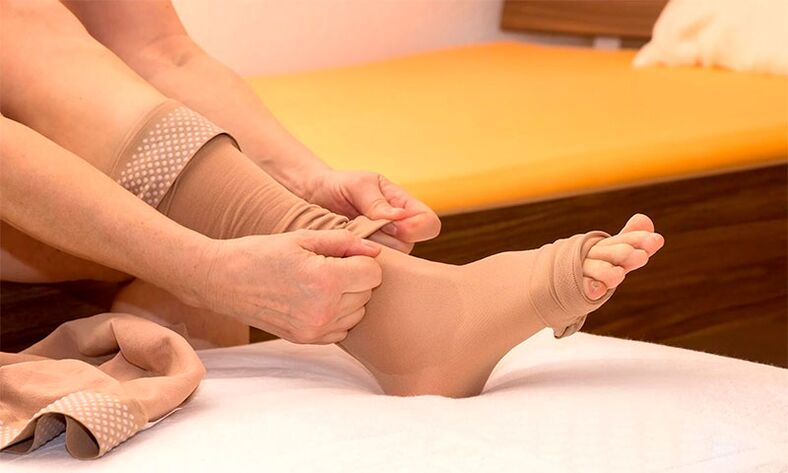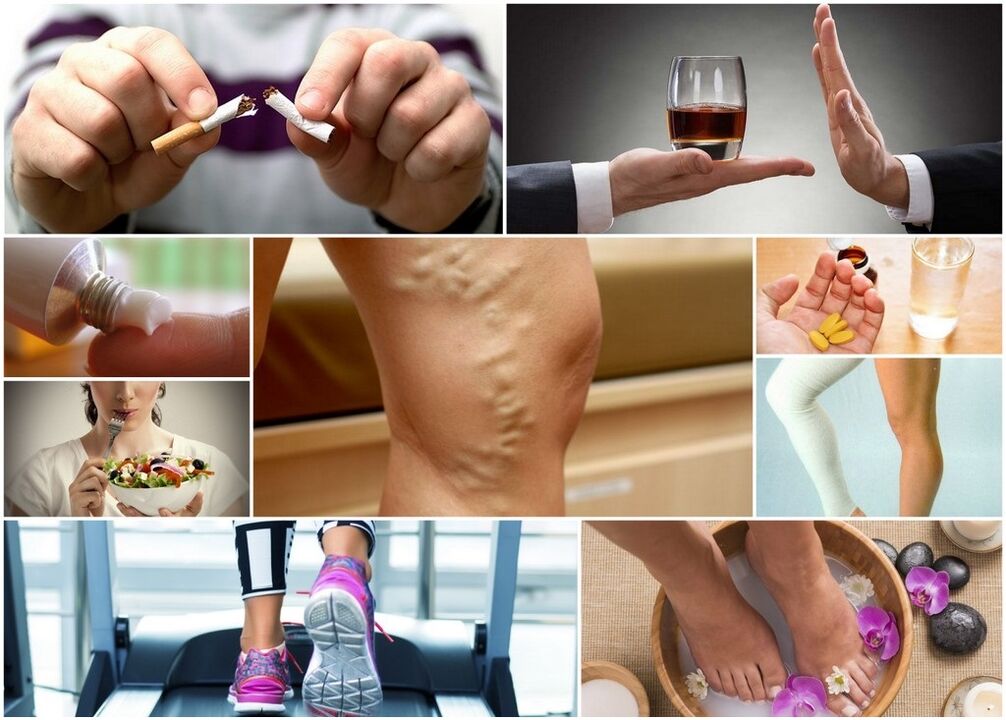Different veins (varicose veins) - a condition in which the veins increase in the diameter, become windings. Most often this is due to impaired operation of venous valves. Venous system. Characteristics of the structure of the veins.
Venous system. Characteristics of the structure of the veins.
Venous vessels are part of the cardiovascular system, carrying blood from peripheral tissues to the heart. The view that venous blood always flows through the veins and the arterials always flow into the veins. In fact, this is not always the case. For example, the pulmonary arteries carry venous blood from the heart to the lungs, and the pulmonary veins return from the lungs to the heart of the arterial.
In many arteries the blood flows under high pressure, so they have a thick dense wall. On the contrary, in the veins the blood pressure is quite low, so their wall is sharper and less thick. There are valves in the lumen of many veins - they only pass blood in one direction, thus contributing to its advancing to the heart. The valves are absent only in the veins of the head and neck, as they are above the heart, the blood flows freely down.What happens in the veins? The essence of varicose veins.
The walls of the veins of the lower limbs are forced to constantly experience increased loads as blood flow through these vessels occurs against gravity. The main mechanisms leading to varicose veins:excessive stretching of the venous wall;Interruption of venous valves.
It is not always possible to say exactly why these pathological changes occur in the veins. There are factors that increase the risk of varicose veins.The causes of varicose veins
Factors that increase the risk of disease:Directing. This factor is present in all people. The legs are the most distant from the heart of the body, which is below the rest during standing and walking. Venous blood is the most difficult to return to the heart from the feet.Age. With the risk of varicose veins, the venous valves wear out. They stop closing completely so that a small amount of blood can flow in the opposite direction. She stagnates in the veins of the legs instead of returning to the heart. Under. Women suffer from varicose veins more often than men. This is facilitated by hormonal changes in the female body during pregnancy, in postmenopause, before menstruation. Female sex hormones contribute to the relaxation of the walls of the veins.Hormone replacement therapy and administration of oral contraceptives.Heredity. The more members of your family suffer from varicose veins of the lower limbs, the higher your risks.Obesity. Surprising pounds contribute to increasing the load of the cardiovascular system. The pressure in the veins increases.Standing or sitting for a long time. This leads to stagnation of blood in the veins of the lower body. For example, office workers, surgeons and other people who "stand" and "sit" often suffer from varicose veins.Pregnancy. During pregnancy, women suffer from varicose veins much more often than in other periods of life. This is due to some physiological changes in the body of a pregnant woman. Signs of varicose veinsNoticable expansion of subcutaneous veins. They increase, become windings, well visible under the skin. Different varicose veins most often look like cereals, the "worms" of blue or dark purple. Such a picture occurs only with varicose veins located under the skin. If the venous vessels located deeper in the tissues are affected, it is impossible to notice this outside.Feeling of weight in the legs. It usually happens or increases after intense exercise, in the evening and at night.Various unpleasant sensations. This can be a burning sensation, a feeling of pulsation, numbness, numbness.Swelling on the legs. Blood stagnation in varicose veins leads to the fact that the fluid begins to linger and accumulates in the tissues. The edema is more common in the evening, as a rule, first only on the legs. As a disorder of the leakage of venous blood increases, the swelling extends to the lower legs, the hips. Muscle cramps. They occur due to a violation of the blood supply to the tissues when a person has been standing for a long time.Pain in the legs. Not all patients are worried. Strengthen with prolonged standing.Complications of varicose veins
Signs of varicose veinsNoticable expansion of subcutaneous veins. They increase, become windings, well visible under the skin. Different varicose veins most often look like cereals, the "worms" of blue or dark purple. Such a picture occurs only with varicose veins located under the skin. If the venous vessels located deeper in the tissues are affected, it is impossible to notice this outside.Feeling of weight in the legs. It usually happens or increases after intense exercise, in the evening and at night.Various unpleasant sensations. This can be a burning sensation, a feeling of pulsation, numbness, numbness.Swelling on the legs. Blood stagnation in varicose veins leads to the fact that the fluid begins to linger and accumulates in the tissues. The edema is more common in the evening, as a rule, first only on the legs. As a disorder of the leakage of venous blood increases, the swelling extends to the lower legs, the hips. Muscle cramps. They occur due to a violation of the blood supply to the tissues when a person has been standing for a long time.Pain in the legs. Not all patients are worried. Strengthen with prolonged standing.Complications of varicose veins
In most patients, varicose veins do not lead to complications. But the following states may occur:Bleeding. In the case of skin damage in the area of varicose veins, bleeding occurs, which may not stop for a long time. In such cases, you should lie down, lift your legs up and press on the bleeding area. If the blood continues to go, you should consult a doctor.Ulcers for varicose veins. Very painful, most often located in the ankle. Ulcers occur due to edema and impaired blood supply to the tissues in the area of varicose veins. Usually an ulcer is preceded by a pale spot on the skin. If this complication occurs, you should consult a doctor immediately.Thrombophlebitis for varicose veins. A condition in which blood clots grow on the venous wall and inflammation occurs. In the area of damage, a feeling of heat, redness, pain may occur. Usually, with this complication, the doctor prescribes compression linen, painkillers.Chronic venous deficiency. A condition in which the exchange of oxygen, nutrients and waste products between the skin and blood is impaired due to impaired blood supply. Chronic venous deficiency increases the risk of pathologies such as eczema, solid thick skin, trophic ulcers.Venous eczema (stagnant dermatitis). Skin lesion caused by stagnation of venous blood and edema formation. The main symptoms: red spots, peeling, itching in the field of varicose veins.Restless leg syndrome. It is characterized by unpleasant sensations in the legs that occur at rest. The patient should constantly move movements, which is why sleep is often disturbed. Compression linen for varicose veins
Compression socks and elastic bandages with varicose veins compress varicose veins, thus improving blood circulation. As a rule, compression linen envelops the legs around the ankles the most tightly and above gradually becomes more free. It helps the blood move through the veins in the direction of the reverse power of gravity - to the heart.
Many patients note that compression socks and elastic bandages help to cope with discomfort, pain, swelling.
Despite the fact that compression linen helps to improve blood flow and deal with some symptoms, it does not cure varicose veins. During studies, ambiguous results were obtained, so scientists cannot say whether compression socks help to eliminate or prevent varicose veins.
Varieties of compression linen:Socks and tights. The most common type of compression washing. The socks reach the hips, tights to the waist. Compression tights are the most convenient as they are securely fixed and do not slide.Golf. They reach the knee. Often used by men. There are different models.Elastic bandages. There are different lengths, it can only be intended to convert the lower legs or lower legs and thighs. This is the cheapest, but the most unlikely variety of compression linen. The border should be applied longer than wearing tights or socks, it constantly slides. The degree of compression is manually controlled by adjusting the dressing force and is not always adequate. Varicose veins
With pronounced varicose veins of the legs, they resort to surgical treatment. Usually surgery is performed with general anesthesia. In most cases, the patient is discharged from the hospital on the day of surgery. If the surgery is performed on two legs, then you may need to spend one night in the hospital.
There are different types of surgical treatment of varicose veins.Dressing and removing a varicose vein
Two cuts are made: one in the groin, the other from below, in the ankle, knee or elsewhere. At the top there is, becoming, bandaged and crossed by a vein. It performs a special thin wire to the bottom, after which it is pulled together with below. Removing the surface vein will not affect the blood supply of the legs as its functions will acquire deep veins.
Possible complications from the dressing and removal of the vein:the formation of large hemorrhages;bleeding;pain;A very rare complication is the thrombosis of the deep vein.
The restoration of effectiveness after such surgery in most patients occurs within 1-3 weeks. All this time you will need to wear compression socks. If there is venous insufficiency, compression linen will need to be used in the long run.Sclerotherapy
During this procedure, a special substance is introduced into the vein, which damages its wall inside and leads to the overlap of the lumen. Varicose takes place within a few weeks. Sometimes the drug should be administered several times.
Radio
The technique provides heating of the vein wall with the help of radio frequency energy. The course of the procedure: A small incision is made above or below the knee and access to Vienna. Under the control of the ultrasound, a catheter (half a flexible tube) is performed in a vein.Then, through the catheter, the doctor conducts a probe that emits radio frequency energy.The energy emitted by the probe heats up the wall of the veins inside, causes its burning and closure of the lumen of the vessel.
A small incision is made above or below the knee and access to Vienna. Under the control of the ultrasound, a catheter (half a flexible tube) is performed in a vein.Then, through the catheter, the doctor conducts a probe that emits radio frequency energy.The energy emitted by the probe heats up the wall of the veins inside, causes its burning and closure of the lumen of the vessel.
Usually this surgery is performed with local anesthesia, without anesthesia. During the procedure, the patient may experience small unpleasant sensations that resemble pins. Sometimes a little burning of the skin occurs. Within a few weeks after radio frequency ablation, compression linen should be worn.Treatment of varicose veins with laser
The closure of the lumen of the vein can also be caused by irradiation of its wall inside with a laser. The course of the procedure:A catheter is introduced into the vein of the patient.A source of laser radiation is carried out through a catheter near Vienna.The laser causes the vein heating, the burning of its walls inside and the ceiling of the lumen.The surgeon directs the laser rays under the control of the ultrasound and gradually burns the wall of the veins.
As a rule, the treatment of varicose veins with laser is performed under local anesthesia. The procedure is effective in 98% of cases.Exercise for varicose veins
Therapeutic gymnastics can be useful for varicose veins. Below we will look at the simplest set of exercises, but before your performance you should definitely consult a doctor. Only your doctor will be able to tell exactly which loads are not contraindicated for you and are able to benefit.
How gymnastics can help with varicose veins:improving the leakage of venous and lymphatic vessels; improving the blood supply to the lower limbs;increase in the tone of the walls of the veins;improving blood circulation in small vessels;Strengthening the leg muscles, increasing their endurance.Varicose
Massage can be used for varicose veins, but not always depends on the degree of severity and the presence of complications. Do not participate in a self -massage, it is better to contact a professional massage therapist.
Massage for varicose veins helps reduce symptoms such as swelling, convulsions, numbness and other discomfort. It relieves muscle tension and helps to restore the normal tone of the venous walls. With varicose veins, massage is often combined with physiotherapy exercises.How to deal with varicose veins at home?
There are some measures that can be used independently at home to slow the progression of varicose veins and to reduce the feeling of discomfort to which it is accompanied by: Physical activity. Walking helps to strengthen the muscles of the legs and improve the leakage of venous blood. Consult your doctor, he will recommend the level of physical activity that is right for you.Maintaining a healthy weight. Stick to a healthy diet. If you suffer from excess weight or obese, try to get rid of extra pounds. Consult a nutritionist: A specialist will make recommendations for the nature of the food, which will be optimal in your case.The right choice of clothes. Do not wear high -content shoes, tight linen and clothes that squeeze the veins.Lifting your feet up. It will be very good if you can periodically take breaks and raise your feet above your heart level. When you sleep or just lie on the bed, put 3-4 pillows under your feet. Fractures with a long sitting or standing. Try to move every 30 minutes.Do not place your foot on your feet when sitting. Therefore, the veins are squeezed, blood leakage is even more abused.Prevent varicose veins
Physical activity. Walking helps to strengthen the muscles of the legs and improve the leakage of venous blood. Consult your doctor, he will recommend the level of physical activity that is right for you.Maintaining a healthy weight. Stick to a healthy diet. If you suffer from excess weight or obese, try to get rid of extra pounds. Consult a nutritionist: A specialist will make recommendations for the nature of the food, which will be optimal in your case.The right choice of clothes. Do not wear high -content shoes, tight linen and clothes that squeeze the veins.Lifting your feet up. It will be very good if you can periodically take breaks and raise your feet above your heart level. When you sleep or just lie on the bed, put 3-4 pillows under your feet. Fractures with a long sitting or standing. Try to move every 30 minutes.Do not place your foot on your feet when sitting. Therefore, the veins are squeezed, blood leakage is even more abused.Prevent varicose veins
It is impossible to completely prevent varicose veins. Existing preventive measures only help to slow down the disease or slow down its progression if it has already arisen.If you need to sit or stand for a long time, be sure to take breaks. Go, leave. If possible, you can lie down and lift your feet.Try to keep your feet raised when you sit, rest, sleep. Sometimes it is useful to go to the sofa or on the floor and hold their feet, raised, misleading them on the wall.The more your feet are higher than your heart level, the better for their veins.Do exercise that help strengthens the muscles of the legs. Thanks to this, blood movement will improve through the veins.If you have overweight or obese, try to lose weight. Not only will this reduce the risks of varicose veins, but it will also positively affect the condition of the entire cardiovascular system.Do not wear tight clothes, especially those that are pulled into the waist, groin, legs. Because of it, blood flow through the veins may deteriorate.Try to wear high shoes with as much as possible. Therefore, the tone of the leg muscles is disturbed, they stop to help the blood through the veins.






















